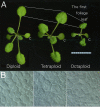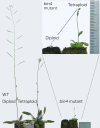Controlling size in multicellular organs: focus on the leaf
- PMID: 18630989
- PMCID: PMC2459211
- DOI: 10.1371/journal.pbio.0060174
Controlling size in multicellular organs: focus on the leaf
Abstract
In leaves, cells get larger as cell division decreases or the ploidy increases. This might seem a logical response, but the controls are more complicated.
Figures



References
-
- Tsukaya H. Relationship between shape of cells and shape of the organ. In: Imazeki H, Shibaoka H, editors. Phytohormones and cell shape. Tokyo: Gakkai-shuppann Center; 1998. pp. 177–184. [In Japanese.]
-
- Tsukaya H. Interpretation of mutants in leaf morphology: Genetic evidence for a compensatory system in leaf morphogenesis that provides a new link between cell and organismal theory. Int Rev Cytol. 2002;217:1–39. - PubMed
-
- Beemster GT, Fiorani F, Inzé D. Cell cycle: The key to plant growth control. Trends Plant Sci. 2003;8:154–158. - PubMed
-
- Tsukaya H, Beemster G. Genetics, cell cycle and cell expansion in organogenesis in plants. J Plant Res. 2006;119:1–4. - PubMed
Publication types
MeSH terms
LinkOut - more resources
Full Text Sources
Other Literature Sources

